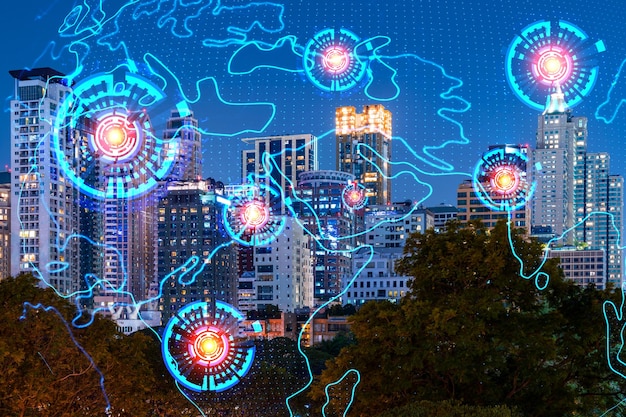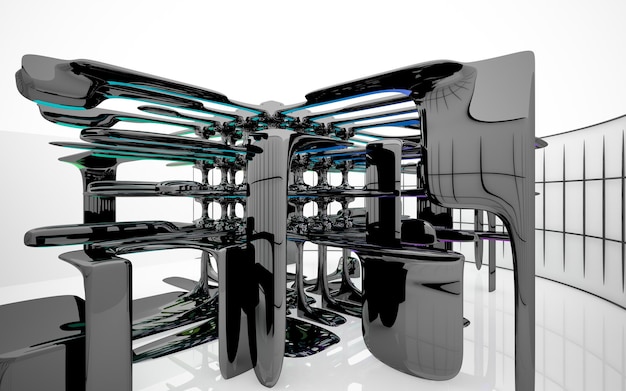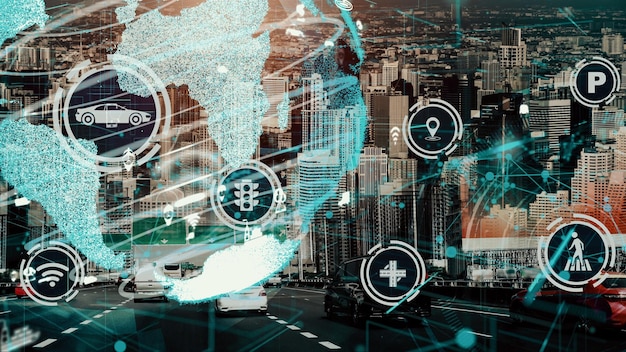Edge Computing: Transforming Industries in 2025

Edge computing is poised to revolutionize industries by 2025, bringing processing power closer to data sources, enhancing real-time decision-making, and enabling the Internet of Things (IoT) to reach its full potential with faster, more secure, and efficient operations.
The landscape of technology is perpetually evolving, and one innovation set to redefine how industries operate is the rise of Edge Computing: How It’s Transforming Industries in 2025. This paradigm shift is placing computational power nearer to data sources, promising unprecedented speed, reduced latency, and enhanced security across various sectors.
Understanding the Essence of Edge Computing
Edge computing represents a significant departure from traditional cloud computing models. Instead of relying solely on centralized data centers, edge computing distributes processing capabilities to the ‘edge’ of the network, closer to where data is generated and consumed.
This proximity offers several key advantages, including reduced latency, improved bandwidth utilization, and enhanced data privacy. Understanding these core principles is crucial to grasping the transformative potential of edge computing.
Decentralized Processing Power
Edge computing empowers devices and local servers to process data independently, reducing the need for constant communication with central servers. This decentralized approach is particularly beneficial in scenarios where real-time decision-making is critical.
Key Benefits of Edge Computing
- Reduced Latency: Processing data locally minimizes delays, enabling faster response times for critical applications.
- Improved Bandwidth Utilization: By processing data at the edge, less data needs to be transmitted to centralized servers, freeing up bandwidth for other applications.
- Enhanced Data Privacy: Processing sensitive data locally reduces the risk of data breaches and unauthorized access.
In essence, edge computing is about bringing computing power closer to the source of data, enabling faster, more efficient, and more secure operations across a wide range of industries. By decentralizing processing power, edge computing opens up new possibilities for innovation and optimization.

The Impact on Manufacturing
The manufacturing sector stands to gain significantly from the adoption of edge computing. By enabling real-time monitoring, predictive maintenance, and optimized production processes, edge computing can drive efficiency and reduce downtime.
Smart factories are becoming a reality, with edge computing playing a pivotal role in connecting and coordinating various aspects of the manufacturing process.
Real-Time Monitoring and Control
Edge computing allows manufacturers to monitor equipment performance in real-time, identify potential issues before they arise, and make adjustments on the fly. This level of control enables proactive maintenance and minimizes disruptions.
Predictive Maintenance
By analyzing data collected from sensors and other devices, edge computing can predict when equipment is likely to fail, allowing manufacturers to schedule maintenance proactively and avoid costly downtime. Here are some potential advantages:
- Improved equipment uptime
- Reduced maintenance costs
- Optimized production schedules
Edge computing’s impact on manufacturing is profound, enabling smarter, more efficient, and more resilient operations. From real-time monitoring to predictive maintenance, the possibilities are vast and transformative. The adoption of edge computing is not just a technological upgrade; it is a strategic imperative for manufacturers looking to stay competitive in the evolving landscape.
Revolutionizing Healthcare with Edge Computing
The healthcare industry is undergoing a digital transformation, and edge computing is playing a crucial role in enabling innovative solutions. From remote patient monitoring to real-time diagnostics, edge computing is enhancing patient care and improving healthcare outcomes.
The ability to process data locally and securely is particularly important in healthcare, where patient privacy and data security are paramount.
Remote Patient Monitoring
Edge computing enables healthcare providers to monitor patients remotely, collecting vital signs and other data in real-time. This allows for proactive intervention and improved patient outcomes, especially for patients with chronic conditions.
Real-Time Diagnostics
Edge computing can facilitate real-time diagnostics by processing medical images and other data at the point of care. This can speed up diagnosis, improve accuracy, and enable more timely treatment decisions. By 2025, we can expect:
- Faster diagnosis times
- Improved accuracy in diagnostics
- More timely treatment decisions
The intersection of healthcare and edge computing holds immense promise for improving patient care and healthcare outcomes. As technology continues to advance, the possibilities for edge computing in healthcare are vast and transformative. Embracing edge computing is not merely an upgrade; it is a strategic imperative for healthcare providers seeking to enhance patient care and stay at the forefront of medical innovation.
Transforming Transportation and Logistics
The transportation and logistics industries are becoming increasingly reliant on data-driven insights. Edge computing is enabling real-time tracking, optimized routing, and improved safety, transforming how goods and people are moved around the world.
Autonomous vehicles, smart traffic management systems, and optimized supply chains are all benefiting from the capabilities of edge computing.
Real-Time Tracking and Routing
Edge computing allows transportation companies to track vehicles and shipments in real-time, optimizing routes and delivery schedules. This leads to reduced costs, improved efficiency, and enhanced customer satisfaction.
Enhanced Safety Measures
Edge computing can enhance safety by processing data from sensors and cameras in real-time, detecting potential hazards, and alerting drivers or autonomous systems. This can prevent accidents and improve overall safety on the roads. The benefits include:
- Reduced accident rates
- Improved traffic flow
- Enhanced safety for drivers and pedestrians
Edge computing is revolutionizing transportation and logistics by enabling smarter, safer, and more efficient operations. As technology continues to advance, the integration of edge computing will only deepen, paving the way for a future where transportation is seamless, sustainable, and highly optimized. Embracing edge computing is not just a technological upgrade; it’s a strategic imperative for those aiming to lead in the rapidly evolving landscape of transportation and logistics.

Empowering the Internet of Things (IoT)
The Internet of Things (IoT) is generating massive amounts of data, and edge computing is essential for processing and analyzing this data in real-time. By bringing computing power closer to IoT devices, edge computing enables faster response times, reduced latency, and improved security.
Smart homes, smart cities, and industrial IoT deployments are all benefiting from the capabilities of edge computing. Let dive into some key implications.
Smart Homes and Smart Cities
Edge computing enables smart homes and smart cities to respond to changing conditions in real-time, optimizing energy consumption, improving traffic flow, and enhancing public safety. This leads to more efficient, sustainable, and livable urban environments.
Industrial IoT (IIoT) Deployments
Edge computing is essential for IIoT deployments, enabling real-time monitoring, predictive maintenance, and optimized production processes. This leads to improved efficiency, reduced downtime, and enhanced productivity in industrial settings. Here’s what you can find:
- Real-time data processing
- Improved security for IoT devices
- Enhanced automation and control
Edge computing is a catalyst for the growth and evolution of the IoT, enabling smarter, faster, and more secure applications across a wide range of industries and environments. As the number of connected devices continues to grow, the importance of edge computing will only increase. Embracing edge computing is not just a technological upgrade; it’s a strategic imperative for organizations looking to harness the full potential of the IoT.
Challenges and Opportunities
While the potential of edge computing is immense, there are also challenges that need to be addressed. These include security concerns, interoperability issues, and the need for skilled professionals to manage and maintain edge infrastructure.
However, these challenges also present opportunities for innovation and growth. As the edge computing ecosystem matures, we can expect to see new solutions and business models emerge.
Addressing Security Concerns
Security is a top priority for edge computing deployments. Protecting edge devices and data from cyber threats requires robust security measures, including encryption, access controls, and intrusion detection systems.
Overcoming Interoperability Issues
Ensuring that different edge devices and platforms can communicate and work together seamlessly is crucial for realizing the full potential of edge computing. Standardization efforts and open-source initiatives can help address interoperability issues.
While challenges exist, the opportunities for innovation and growth in the edge computing ecosystem are substantial. Companies that can successfully navigate these challenges will be well-positioned to capitalize on the transformative potential of this technology. Facing these challenges head-on will pave the way for widespread adoption, unlocking innovation, and setting the stage for long-term success.
| Key Aspect | Brief Description |
|---|---|
| 💡 Manufacturing | Real-time monitoring and predictive maintenance enhance efficiency. |
| 🏥 Healthcare | Remote patient monitoring and faster diagnostics improve care. |
| 🚚 Transportation | Optimized routing and improved safety measures transform logistics. |
| 🌐 IoT | Faster data processing enables smarter homes and efficient industries. |
FAQ Section
▼
Edge computing is a distributed computing paradigm that brings computation and data storage closer to the location where it is needed, to improve response times and save bandwidth.
▼
Cloud computing relies on centralized data centers, while edge computing distributes processing to the network’s edge, reducing latency and improving efficiency.
▼
Key benefits include reduced latency, improved bandwidth utilization, enhanced data privacy, and the ability to process data in real-time, closer to the source.
▼
Manufacturing, healthcare, transportation, logistics, and any industry leveraging the Internet of Things (IoT) can significantly benefit from edge computing solutions.
▼
Challenges include addressing security concerns, ensuring interoperability between devices, and managing the complexity of distributed edge infrastructure.
Conclusion
As we journey into 2025, edge computing is not just a technological advancement but a transformative force poised to reshape industries across the board. Embracing this shift will enable businesses to thrive in an increasingly data-driven and interconnected world, unlocking new levels of efficiency, innovation, and competitive advantage.